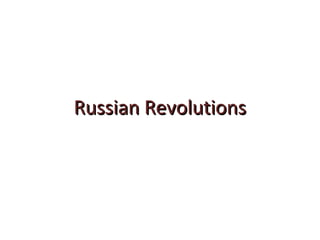
Russian Revolutions_ group construction
- 2. Antecedents of Russian Revolution •During the XIX century Russia lived in an almost feudal system. The cruel and oppressive autocratic rule of the czars caused social unrest because of the awful life and working conditions. •Late 1800’s. Russo – Japanese War. Russia and Japan firm a peace treaty. Russia keeps Manchuria and Japan keeps Korea. •1894. Czar Nicolas II succeeds in throne. He continues with policies as: oCensorship code oSecret Police oReligious persecution oIndustrialization It promotes Strikes and the rice of Marxist Movements •1903 Marxists split into two: oMensheviks (Moderates) oBolsheviks with Lenin (Radicals) •Russia breaks Russo – Japanese treaty and Japan attacks Manchuria (Russian territory)
- 3. •1905 “Bloody Sunday” workers are killed in a protest in St. Petersburg •Because of the social unrest the Czar creates the DUMA (Russian 1st Parliament). He closes it after 10 weeks. •1914 Russia enters in WWI •1915 The Czar goes to the front but soldiers don’t respond to him showing his weakness •1915 Czarina Alexandra rules at home •1917 “March Revolution” to end autocracy and war. •The Czar abdicates •DUMA provisional government starts on the head of Alexander Kerensky •Kerensky continues with WWI and has to leave the government •Socialist revolutionaries form SOVIETS (Local Councils) •April, 1917. Lenin returns to Russia
- 4. Tsar Nicholas II • Nikolai Aleksandrovich Romanov was born • in 1868, the eldest son of Tsar Alexander III. • In 1894, his father died and he became tsar; • he continued the tradition of Russian autocracy. He married Alexandra Feodorovna and they had five children. • In 1914, he took Russia into WWI which revealed his weaknesses of rule and military leadership. • In 1917 he was forced to abdicate his throne and a year later Nicholas and his family were executed by the Bolsheviks.
- 5. Leaders of the Russian Revolution Russian MarxistsRussian Marxists 1.1.MensheviksMensheviks 2.2.Bolsheviks (Red Army)Bolsheviks (Red Army) Vladimir Ilyich Ulyanov “Lenin” (1870-1924)Vladimir Ilyich Ulyanov “Lenin” (1870-1924) • Lenin’s brother was hanged for plotting to kill the czar(1887), so heLenin’s brother was hanged for plotting to kill the czar(1887), so he harbored ill feelings against the government.harbored ill feelings against the government. • The major leader of the Bolsheviks , ruthless, planned to overthrowThe major leader of the Bolsheviks , ruthless, planned to overthrow the czar by the early 1900s.the czar by the early 1900s. • He fled to avoid his arrest by the czarist regime; in 1917 he returnedHe fled to avoid his arrest by the czarist regime; in 1917 he returned to Russia and Bolsheviks were in power.to Russia and Bolsheviks were in power. • Lenin’s communist state –the Union of Soviet Socialist RepublicsLenin’s communist state –the Union of Soviet Socialist Republics (USSR)- became one-party, totalitarian system.(USSR)- became one-party, totalitarian system. • He suffered a stroke in 1922, and, unable to be the head of hisHe suffered a stroke in 1922, and, unable to be the head of his Party, died in 1924.Party, died in 1924.
- 6. Leon TrotskyLeon Trotsky • Revolutionary leader.Revolutionary leader. • Commanded the Bolshevik Red Army, while civil war raged in RussiaCommanded the Bolshevik Red Army, while civil war raged in Russia from 1928 to 1920.from 1928 to 1920. • He was one of the most notable men when Lenin’s incident set inHe was one of the most notable men when Lenin’s incident set in motion competition for heading up the Communist Party.motion competition for heading up the Communist Party. • Trotsky was forced to exile in 1929, and was no longer a threat forTrotsky was forced to exile in 1929, and was no longer a threat for Stalin.Stalin. Joseph StalinJoseph Stalin • Cold, hard, and impersonal. During his early days as a Bolshevik, heCold, hard, and impersonal. During his early days as a Bolshevik, he change his name to Stalin, which means “man of steel”.change his name to Stalin, which means “man of steel”. • As Trotsky, he was also a commander of the Red Army.As Trotsky, he was also a commander of the Red Army. • Between 1922 and 1927, he began his ruthless climb to the head ofBetween 1922 and 1927, he began his ruthless climb to the head of the government. He started to be a general secretary, moving histhe government. He started to be a general secretary, moving his supporters into positions of power.supporters into positions of power. • By 1928, Stalin was in total command of the Communist Party.By 1928, Stalin was in total command of the Communist Party.
- 7. How did people react before and during the Revolution?
- 8. •People were disconted because of the rapid industrialization stired them. •The growth of factories brought new problems, such as grueling working conditions, miserably law wages and child labor. •Bloody Sunday: The Revolution of 1905 or January 22; about 200.000 workers and their families approached the Czar’s Winter Palace un St. Petersburg fought for the rights (such as: better working conditions, more personal freedom and an elected national legislature).
- 9. •More than 1.000 people were wounded and several hundred were killed (into Bloody Sunday). •Civil War Rages in Russia between 1918-1920 (White Army) Some supported return to rule by Czar and others who wanted the democratic government.
- 10. Consequences
- 11. Consequences Russian Civil War 14 million deaths (between the three year struggle and the big famine)
- 12. - War and revolution destroyed Russian economy.War and revolution destroyed Russian economy. - Lenin turned to reviving the economy and restructuring- Lenin turned to reviving the economy and restructuring the government applying “the new economic policy”.the government applying “the new economic policy”. - In 1922 the country is named USSR.- In 1922 the country is named USSR. - In 1928 as Lenin suffered a stroke, Stalin takes the- In 1928 as Lenin suffered a stroke, Stalin takes the command of the Comunist Party and he becames acommand of the Comunist Party and he becames a dictator.dictator.
